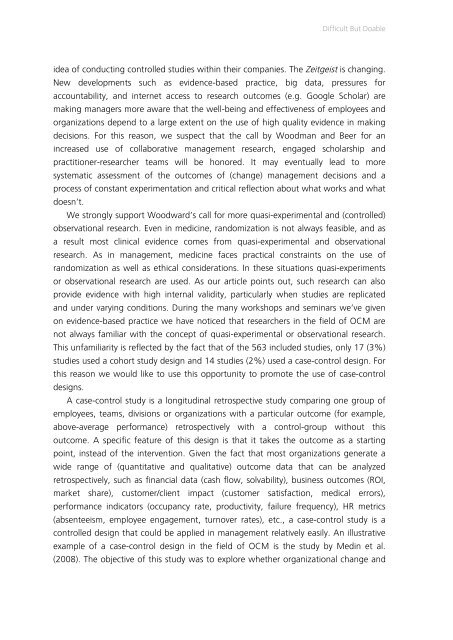In Search of Evidence
jqluvth
jqluvth
You also want an ePaper? Increase the reach of your titles
YUMPU automatically turns print PDFs into web optimized ePapers that Google loves.
Difficult But Doable<br />
idea <strong>of</strong> conducting controlled studies within their companies. The Zeitgeist is changing.<br />
New developments such as evidence-based practice, big data, pressures for<br />
accountability, and internet access to research outcomes (e.g. Google Scholar) are<br />
making managers more aware that the well-being and effectiveness <strong>of</strong> employees and<br />
organizations depend to a large extent on the use <strong>of</strong> high quality evidence in making<br />
decisions. For this reason, we suspect that the call by Woodman and Beer for an<br />
increased use <strong>of</strong> collaborative management research, engaged scholarship and<br />
practitioner-researcher teams will be honored. It may eventually lead to more<br />
systematic assessment <strong>of</strong> the outcomes <strong>of</strong> (change) management decisions and a<br />
process <strong>of</strong> constant experimentation and critical reflection about what works and what<br />
doesn’t.<br />
We strongly support Woodward’s call for more quasi-experimental and (controlled)<br />
observational research. Even in medicine, randomization is not always feasible, and as<br />
a result most clinical evidence comes from quasi-experimental and observational<br />
research. As in management, medicine faces practical constraints on the use <strong>of</strong><br />
randomization as well as ethical considerations. <strong>In</strong> these situations quasi-experiments<br />
or observational research are used. As our article points out, such research can also<br />
provide evidence with high internal validity, particularly when studies are replicated<br />
and under varying conditions. During the many workshops and seminars we’ve given<br />
on evidence-based practice we have noticed that researchers in the field <strong>of</strong> OCM are<br />
not always familiar with the concept <strong>of</strong> quasi-experimental or observational research.<br />
This unfamiliarity is reflected by the fact that <strong>of</strong> the 563 included studies, only 17 (3%)<br />
studies used a cohort study design and 14 studies (2%) used a case-control design. For<br />
this reason we would like to use this opportunity to promote the use <strong>of</strong> case-control<br />
designs.<br />
A case-control study is a longitudinal retrospective study comparing one group <strong>of</strong><br />
employees, teams, divisions or organizations with a particular outcome (for example,<br />
above-average performance) retrospectively with a control-group without this<br />
outcome. A specific feature <strong>of</strong> this design is that it takes the outcome as a starting<br />
point, instead <strong>of</strong> the intervention. Given the fact that most organizations generate a<br />
wide range <strong>of</strong> (quantitative and qualitative) outcome data that can be analyzed<br />
retrospectively, such as financial data (cash flow, solvability), business outcomes (ROI,<br />
market share), customer/client impact (customer satisfaction, medical errors),<br />
performance indicators (occupancy rate, productivity, failure frequency), HR metrics<br />
(absenteeism, employee engagement, turnover rates), etc., a case-control study is a<br />
controlled design that could be applied in management relatively easily. An illustrative<br />
example <strong>of</strong> a case-control design in the field <strong>of</strong> OCM is the study by Medin et al.<br />
(2008). The objective <strong>of</strong> this study was to explore whether organizational change and


